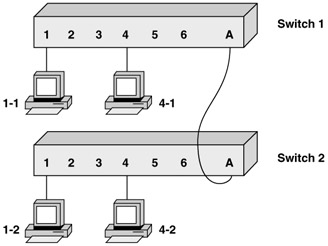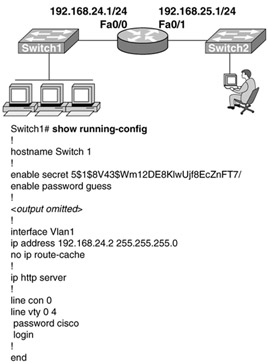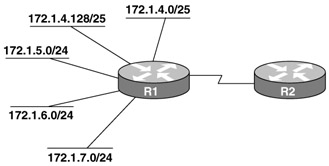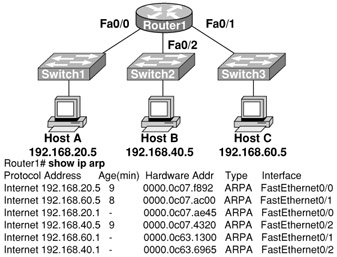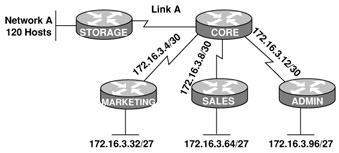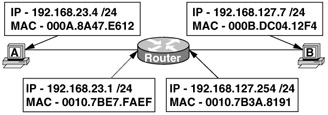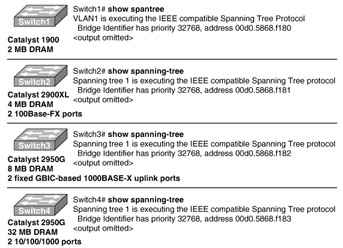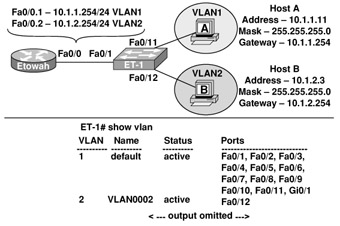CCNA-Practice Test 3
Directions: For each of the following questions, select the choice that best answers the question or completes the statement.
| 1. | You have been asked to allow only certain MAC addresses to attach to the switch. Which of the following should you enable?
| | ||||||||||||||||||||
| 2. | Look at the following diagram. Assume that ports 1 through 3 are designated to VLAN1 and ports 4 through 6 are designated to VLAN2 on each switch. Further, assume that your switches connect via a trunk link. Pick the three events that confirm that both your VLAN and trunk are working correctly.
| | ||||||||||||||||||||
| 3. | Look at the following diagram. You can see the partial output from four switches. Choose the switch that acts as the spanning-tree root bridge for a network that's limited to the following four devices.
Vail#sh spanning-tree VLAN0001 Spanning tree enabled protocol ieee Root ID Priority 32768 Address 0005.dccb.d740 Hello Time 2 sec Max Age 20 sec Forward Delay 15 sec Aspen#sh spanning-tree VLAN0001 Spanning tree enabled protocol ieee Root ID Priority 16384 Address 0005.dccb.d739 Hello Time 2 sec Max Age 20 sec Forward Delay 15 sec Breckenridge#sh spanning-tree VLAN0001 Spanning tree enabled protocol ieee Root ID Priority 8192 Address 0005.dccb.d738 Hello Time 2 sec Max Age 20 sec Forward Delay 15 sec Keystone#sh spanning-tree VLAN0001 Spanning tree enabled protocol ieee Root ID Priority 4096 Address 0005.dccb.d737 Hello Time 2 sec Max Age 20 sec Forward Delay 15 sec Figure 3-2 | | ||||||||||||||||||||
| 4. | From the following output, choose the two possible causes for status "Serial0/0 is down". Code Listing 3-1
Corp#show interface s0/0 Serial0/0 is down, line protocol is down Hardware is PowerQUICC Serial Internet address is 10.0.10.2/24 MTU 1500 bytes, BW 1544 Kbit, DLY 20000 usec, rely 255/255, load 4/255 Encapsulation HDLC, loopback not set, Keepalive set (10 sec) [output cut]
| | ||||||||||||||||||||
| 5. | Choose the two of the following that best describe the process identifier used to run OSPF on a router.
| | ||||||||||||||||||||
| 6. | Over a Telnet session, you find that you can't connect to Switch1, but you can ping the router interface Fa0/0 via the host machines attached to the switch. Both the router and Switch1 are configured properly. Looking at the following diagram, choose one set of the following commands you should use on Switch1 to solve the problem.
| | ||||||||||||||||||||
| 7. | The Sharper Edge chain of ski shops wants to re-design its network that connects its three locations. The administrator gave the networking team 192.168.128.0 to use for addressing the entire network. After subnetting the address, the team is ready to assign the addresses. The administrator plans to configure ip subnet-zero and use RIP v2 as the routing protocol. As a member of the networking team, you must address the network and at the same time conserve unused addresses for future growth. With those goals in mind, match the host addresses on the left to the correct router interface.
| | ||||||||||||||||||||
| 8. | When routing a packet, which functions do routers perform? (Choose two.)
| | ||||||||||||||||||||
| 9. | Which of the following adds a default route to a router?
| | ||||||||||||||||||||
| 10. | When a router is connected to a Frame Relay WAN link using a serial DTE interface, how can the interface clock rate be established?
| | ||||||||||||||||||||
| 11. | Your switched network is running Spanning Tree Protocol. Choose from the following statements the one that describes when it's completely converged.
| | ||||||||||||||||||||
| 12. | Look at the following diagram. Choose the best summarization R1 can employ to display its networks to R2.
| | ||||||||||||||||||||
| 13. | When dealing with Frame Relay multipoint subinterfaces, which statement best describes what's true about them?
| | ||||||||||||||||||||
| 14. | Look at the following diagram. Which subnet address you would use for Network A?
| | ||||||||||||||||||||
| 15. | What is the default administrative distance for OSPF?
| | ||||||||||||||||||||
| 16. | All of your OSPF routers in one location are configured with the same priority value. Without a loopback interface, which of the following is the value a router will use for the OSPF router ID?
| | ||||||||||||||||||||
| 17. | Look at the following diagram. You need Host A to send data to Host B. Choose the three true statements that describe how Router1 will deal with a data frame it receives from Host A.
| | ||||||||||||||||||||
| 18. | Which two reasons describe why you would encapsulate an ISDN link with PPP instead of HDLC?
| | ||||||||||||||||||||
| 19. | You've configured a Cisco router and entered the copy running-config startup-config command, but when the router is power cycled, it gives you the prompt, "Would you like to enter the initial configuration dialog? [yes/no]:" Why is it doing this?
| | ||||||||||||||||||||
| 20. | Look at the following diagram. Assume that every router is configured with the ip subnet-zero command. Choose the two network addresses you would use for Link A and Network A.
| | ||||||||||||||||||||
| 21. | Which two of the following are reasons a network administrator would use access lists?
| | ||||||||||||||||||||
| 22. | Which of the following describes the type of physical network a default Frame Relay WAN is?
| | ||||||||||||||||||||
| 23. | You can't telnet to a router at IP address 203.125.12.1 from a machine with IP address 203.125.12.23, and you think it's a problem with your protocol stack. What can you do that has the best chance of confirming your suspicion?
| | ||||||||||||||||||||
| 24. | You've subnetted a Class C network address with a /27 mask. Choose the address that would be the broadcast address for one of your new subnets.
| | ||||||||||||||||||||
| 25. | How will spanning tree influence the functioning of your network devices if you have redundant links between switches?
| | ||||||||||||||||||||
| 26. | Choose the command you would use to view all EIGRP-feasible successor routes known to Router 1.
| | ||||||||||||||||||||
| 27. | You have two switches, each with a VLAN configured on the switch: one with VLAN 2 and one with VLAN 3. What do you need to use to enable communication between hosts in VLAN 2 and VLAN 3?
| | ||||||||||||||||||||
| 28. | By looking at the following diagram, you can see that Host A and Host B are communicating. Which of the following describes how data will be addressed leaving Host A?
| | ||||||||||||||||||||
| 29. | Match the command sequence on the left with the functions on the right that will properly configure an IP address on an Ethernet interface.
| | ||||||||||||||||||||
| 30. | If a host has an IP address of 172.16.211.0/22, which of the following is the subnetwork number?
| | ||||||||||||||||||||
| 31. | Which of the following best describes what a layer 2 switch will do when it receives a frame with a destination MAC address that's not in its MAC address table?
| | ||||||||||||||||||||
| 32. | How are OSPF hello packets on a point-to-point network addressed?
| | ||||||||||||||||||||
| 33. | By looking at the following diagram, choose the two access-list statements you need to permit FTP access to the HR Server from the Internet, but block all other traffic.
| | ||||||||||||||||||||
| 34. | You've configured an OSPF interface with the bandwidth 64 command. What will OSPF determine to be the cost of the link?
| | ||||||||||||||||||||
| 35. | Looking at the following diagram, how can you guarantee that Switch B is elected as the root switch during the STP election process?
| | ||||||||||||||||||||
| 36. | Choose three of the following that accurately represent the OSPF routing protocol.
| | ||||||||||||||||||||
| 37. | Say you entered the ping 192.168.5.2 command to successfully test connectivity to a recently added host machine. Choose the two protocols employed during your test.
| | ||||||||||||||||||||
| 38. | Look at the following diagram. Suppose the four switches it shows are the only ones in the network, and they're connected via redundant links. Choose which one of the four switches will be elected the spanning-tree root bridge.
| | ||||||||||||||||||||
| 39. | Look at the following diagram. Your network's IP address is 172.31.0.0/19, and you want to configure it on the router with the partial configuration. Choose the answer that accurately identifies how many available subnets and hosts you'll have after you complete the configuration.
Current configuration: ! version 12.0 service timestamps debug uptime service timestamps log uptime no service password-encryption ! hostname R1 ! ip subnet-zero ! ! ip classless ip route 0.0.0.0 0.0.0.0 Serial0/0 no ip http server ! <output omitted> Figure 3-12 | | ||||||||||||||||||||
| 40. | The two switches in the following diagram, Core and Core2, are both Catalyst 2950s, and you've created an addressing scheme for each site that looks like this:
Choose the three commands you need to configure on Core2 so you can manage it remotely from any subnet located on your network.
| | ||||||||||||||||||||
| 41. | Choose the two things that will happen if you enter the Switch(config)# vtp mode client command on a Catalyst switch.
| | ||||||||||||||||||||
| 42. | The following diagram displays a partial switch command output. Pay close attention to the topology. The internetwork has some connectivity problems indicated by the inability of Host A to ping Host B. Which of the following should you do to solve the problem?
| | ||||||||||||||||||||
| 43. | Choose the two statements that accurately describe the command ip route 172.16.3.0 255.255.255.0 192.168.2.4.
| | ||||||||||||||||||||
| 44. | You issue the show ip route command that allows you to view the following output. Choose the route that won't be entered into the neighboring router's routing table.
| | ||||||||||||||||||||
| 45. | Choose two options that depict the information a router that's running a link-state protocol uses to create and sustain its topological database.
| | ||||||||||||||||||||
| 46. | Choose the three services that use TCP.
| | ||||||||||||||||||||
| 47. | EIGRP successor routes are stored where?
| | ||||||||||||||||||||
| 48. | Your Breckenridge router adds the following command to the router configuration: ip route 192.168.12.0 255.255.255.0 172.16.12.1. Which two things are true because of this?
| | ||||||||||||||||||||
| 49. | Of these choices, which one is a unicast address?
| | ||||||||||||||||||||
| 50. | You want to configure a switch via a virtual terminal connection from outside your local LAN. Choose two things that you need to do to successfully gain the ability to configure your switch remotely.
| | ||||||||||||||||||||
| 51. | If your router has both physical and logical interfaces, which of the following will establish the OSPF router ID?
| | ||||||||||||||||||||
| 52. | On which OSI layer does the protocol operate that imparts the information you get by using the show cdp neighbors command?
| | ||||||||||||||||||||
| 53. | Choose the command that configures a switch port to use the IEEE standard method of adding VLAN membership information into Ethernet frames.
| | ||||||||||||||||||||
| 54. | You need to configure an existing serial interface so it will receive a second Frame Relay virtual circuit. Which three things do you need to do to achieve this goal?
| | ||||||||||||||||||||
| 55. | You have a Cisco router and a router from another maker that are directly connected through a serial link. What command do you need to issue on the Cisco router to create a WAN connection between the routers?
| |
Answers
| 1. | B Explanation: B. Port Security allows you to create filters based on MAC addresses. | ||||||||||
| 2. | A, D, E Explanation: A, D, E. In this case, there is no router to route between the two VLANs, and thus your hosts should only be able to ping other hosts in the same VLAN. A and E show that hosts in one VLAN can ping hosts in the same VLAN on the other switch. | ||||||||||
| 3. | D Explanataion: D. The switch with the lowest priority (4096, in this case) will become the root bridge. | ||||||||||
| 4. | A, D Explanation: A, D. An interface being in a down/down state indicates a layer 1 problem. That could include an incorrect cable. | ||||||||||
| 5. | A, C Explanation: A, C. The OSPF process ID is locally significant and identifies each individual instance of OSPF running, should multiple instances be running on a single router. | ||||||||||
| 6. | C Explanation: C. The switch does not have a default gateway defined and thus will not be able to support IP communications outside its own subnet. | ||||||||||
| 7. |
Explanation:
| ||||||||||
| 8. | A, C Explanation: A, C. Routers must switch the packets between interfaces and perform path selection based on layer 3 destination addresses. They do not assign VLAN membership, and ARP broadcasts do not cross routers. | ||||||||||
| 9. | D Explanation: D. A static route with a destination network and mask of all zeros is the default route. | ||||||||||
| 10. | A Explanation: A. In a serial connection, one device or end of the cable is the DTE (a router in most cases) and the other device or end of the cable is the DCE (CSU/DSU or ISP device). In this type of connection, the clock rate and control for the connection come from the DCE device. | ||||||||||
| 11. | D Explanation: D. Once every switch port has completed the spanning tree states and is either in blocking or forwarding state, the switched network is said to be converged. | ||||||||||
| 12. | C Explanation: C. 172.1.4.0/22 covers all addresses 172.1.4.0 through 172.1.7.255, exactly what R1 has. | ||||||||||
| 13. | C Explanation: C. Unlike Frame Relay point-to-point subinterfaces, multipoint subinterfaces use one subnet for all PVC connections. Point-to-point uses one subnet for each PVC. | ||||||||||
| 14. | D Explanation: D. You will need a /26 subnet in order to have enough address space for 62 hosts. The address space beginning at 192.168.35.64 is already in use. | ||||||||||
| 15. | C Explanation: C. The default administrative distance for OSPF is 110. | ||||||||||
| 16. | C Explanation: C. When OSPF is configured on a router, a router identification (RID) is created by using the highest IP address on any active interface at the moment of OSPF startup. The RID can be changed by creating a loopback interface, also called a logical interface. This RID is used by routers to determine which router will be a designated router or backup designated router in a broadcast or nonbroadcast multi-access network. | ||||||||||
| 17. | A, C, F Explanation: A, C, F. The layer 2 header will be rebuilt every time it passes through a router. The layer 3 header stays constant from end to end. | ||||||||||
| 18. | A, C Explanation: A, C. PPP is universal, whereas HDLC is vendor proprietary. Additionally, PPP can allow for authentication. | ||||||||||
| 19. | C Explanation: C. The configuration register setting can tell the router to ignore any configuration in startup-config. This is used in the password recovery sequence; however, if it is inadvertently set, it causes the behavior described. | ||||||||||
| 20. | B, D Explanation: B, D. You will need at least a /25 address to for Network A, and the 172.16.3.0 network is the only one available for LinkA. | ||||||||||
| 21. | A, C Explanation: A, C. When connecting two like devices together directly, you must use a crossover cable for them to communicate. | ||||||||||
| 22. | C Explanation: C. Frame Relay is a nonbroadcast, multi-access network. | ||||||||||
| 23. | D Explanation: D. Pinging the loopback address will allow you to verify proper local function of the TCP/IP stack. | ||||||||||
| 24. | E Explanation: E. This is the broadcast address for the 201.57.78.128 network. | ||||||||||
| 25. | D Explanation: D. Spanning Tree discovers redundant links and places them in blocking mode. | ||||||||||
| 26. | C Explanation: C. The EIGRP topology table shows feasible successors. | ||||||||||
| 27. | B Explanation: B. A router is required to communicate between VLANs. Router-to-switch connections use standard straightthrough cables. | ||||||||||
| 28. | B Explanation: B. The destination MAC will be the router, which is local to Host A. The destination IP will be the ultimate destination host. | ||||||||||
| 29. |
Explanation:
| ||||||||||
| 30. | C Explanation: C. The subnetwork is 172.16.208.0. | ||||||||||
| 31. | C Explanation: C. In the case where the destination MAC is unknown, the switch will flood the frame out all ports except the receiving port. | ||||||||||
| 32. | E Explanation: E. OSPF uses multicast address 224.0.0.5 for hello packets. | ||||||||||
| 33. | A, B Explanation: A, B. When allowing FTP traffic, you must allow both the data and control ports. The implicit deny will deny all other traffic. | ||||||||||
| 34. | C Explanation: C. OSPF divides the link bandwidth into the reference bandwidth (100Mbps by default). | ||||||||||
| 35. | B Explanation: B. By assigning a lower priority, you can guarantee that a switch is elected root switch. | ||||||||||
| 36. | A, C, E Explanation: A, C, E. OSPF supports VLSM. The use of areas allows for isolation of routing instability and has extensive controls to use in influencing routing updates. | ||||||||||
| 37. | A, E Explanation: A, E. Your host will use ARP to map a destination IP to a MAC and will use ICMP to communicate with the destination host. | ||||||||||
| 38. | A Explanation: A. Because all priorities are equal, the switch with the lowest MAC address will become root bridge. | ||||||||||
| 39. | F Explanation: F. When subnetting a class B network with a /19 mask, you have 8 subnets of 8190 hosts each (assuming you are using IP subnet zero). | ||||||||||
| 40. | B, D, E Explanation: B, D, E. You must add the default gateway and an IP address to the VLAN1 interface. Additionally, you must add a password to the VTY so you can telnet into the switch. | ||||||||||
| 41. | B, C Explanation: B, C. The switch will forward and process VTP updates. | ||||||||||
| 42. | D Explanation: D. The link to the router must be configured as a trunk port in order for the hosts on the two VLANs to communicate with each other. | ||||||||||
| 43. | A, B Explanation: A, B. This is a standard static route; for a default route, the destination network and mask would be all zeros. No specific administrative distance is specified, so the default will be used. | ||||||||||
| 44. | D Explanation: D. This route already has a hop count of 15, which is the maximum for RIP (the routing protocol running here). | ||||||||||
| 45. | A, C Explanation: A, C. A router running a link-state protocol uses hello packets to find neighbors and form adjacencies. Once an adjacency has been formed, it uses link state advertisement (LSA) packets to exchange topology information and updates when changes occur. | ||||||||||
| 46. | B, D, E Explanation: B, D, E. Each of these uses TCP. | ||||||||||
| 47. | E Explanation: E. Successor routers are stored and found in the topology table. They are copied and placed in the routing table for IP to forward traffic with. | ||||||||||
| 48. | A, C Explanation: A, C. This is a standard static route that sends all traffic for 192.168.12.0/24 through 172.16.12.1. | ||||||||||
| 49. | E Explanation: E. This is a unicast address in the 172.31.128.0 subnet. | ||||||||||
| 50. | A, D Explanation: A, D. The switch must have IP communications configured, and the VTY must have a password in order for you to be able to telnet into the switch. | ||||||||||
| 51. | E Explanation: E. The logical address is preferred over the physical, and the highest address wins. | ||||||||||
| 52. | B Explanation: B. Cisco Discovery Protocol (CDP) is a Cisco proprietary protocol that works at the Data Link layer. | ||||||||||
| 53. | E Explanation: E. There are two trunking encapsulation methods: ISL, which is Cisco propriety, and 802.1q, which is not proprietary. Use the command dot1q when using 802.1q. | ||||||||||
| 54. | A, C, D Explanation: A, C, D. Assuming you did not already create subinterfaces, you will need to remove the IP configuration on the major (physical) interface, create multiple subinterfaces, and configure each of them. | ||||||||||
| 55. | B Explanation: B. PPP is always the best choice in multivendor solutions. |
